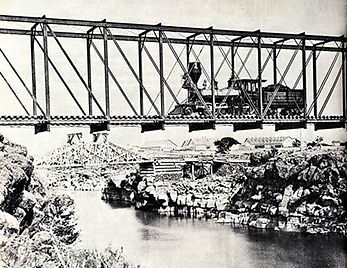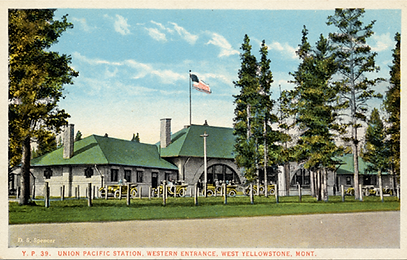

Yellowstone's Supporting Railroads
Union Pacific RR
Copyright 2020 by Robert V. Goss. All rights reserved. No part of this work may be reproduced or utilized in any form by any means, electronic or mechanical, including photocopying, recording or by an information storage and retrieval system without permission in writing from the author.
The Union Pacific Railroad - Yellowstone's Western Access
A Pictorial History of the Early Days

Union Pacific Railroad - Beginnings . . .
In 1862 President Lincoln signed the Pacific Railroad Act that named and directed two companies to construct a transcontinental railroad. The companies would be known as the Union Pacific and Central Pacific. The Act authorized land grants along the rail routes for the railroads as incentive for construction. The Ames brothers, whose shovel business flourished during the ‘Gold Rush’ years, provided the much needed immediate financing. The Central Pacific began construction in 1863 at Sacramento, California and headed east. Union Pacific started at Omaha, Nebraska to head west. The two lines connected in 1869 on May 10 at Promontory, Utah and the famous ‘Golden Spike’ was driven as the official last spike. The company fell into bankruptcy and was sold to a group of investors in 1897 that included railroad tycoon E. H. Harriman. It was Harriman that made the decision in 1905 to run tracks accessing the West entrance of Yellowstone.
The Oregon Short Line & Utah Northern . . .
The Oregon Short Line & Utah Northern came about in 1897 through a reorganization of the Oregon Short Line & Utah Northern RR. That railroad resulted from a merger between the Utah & Northern RR and other small ‘short lines’ in 1889. The Utah & Northern Railway was organized in April 1878 by Union Pacific interests to own and operate the bankrupt Utah Northern Railroad, with the intent to build a rail line from existing tracks in Northern Utah to the gold mines of Montana. Construction began the following year at Brigham City, Utah on a narrow gauge line. The tracks reached Butte on December 26, 1881, after a long lull in construction resulting from the ‘Panic of 1873’

Right Top: Utah Northern bridge at Eagle Rock (Idaho Falls) ca1880
Right Bottom: Union Pacific train crossing trestle enroute to West Yellowstone, undated. Yellowstone Historic Center.
The Bassett Brothers began stage service that year to Yellowstone from Beaver, Idaho. Stage service to the park from the Monida station, located along the Montana-Idaho, border began in the 1890’s. The St. Anthony RR began building tracks from the main line at Idaho Falls to St. Anthony in 1899. Six years later UPRR President Harriman decided to open a line from St. Anthony to the west entrance of Yellowstone. The line was completed in November 1907 and the 1st scheduled passenger train arrived in the town of Riverside (now West Yellowstone) on June 11. The Oregon Short Line took over legal ownership of the line from St. Anthony RR in 1911 and in 1935 merged with the Union Pacific RR. Union Pacific provided much of the financing for these ventures


Monida
The small town of Monida was located along the Montana-Idaho border where Interstate I-15 currently passes through between Dillon, MT and Idaho Falls. The old stage route also passed along that route, along with the Union Pacific RR. There was a post office there between 1891-93 and 1896-1964. The Bassett Brothers continued to haul their stage passengers from Beaver into Yellowstone, while FJ Haynes’ Monida & Yellowstone Stage Co. began hauling tourists into Yellowstone from Monida in 1898 and continued until 1907, when the UPRR extended their lines to the west entrance of the park. The old route to the park roughly followed Montana Route 509 through the Centennial Valley and past Henry’s Lake. It skirted the Centennial Valley, Red Rock Lakes, passed through Alaska Basin and crossed the Divide to Henry Lake; then over Targhee Pass to the west entrance of the park.


Left Top: Town of Monida, Real-Photo PC postmarked 1908.
Right Top: Summit Hotel in Monida, from 1902 brochure.
Right Bottom: Railroad depot at Monida, from undated glass slide.

Where Gush the Geysers
Cover page from the UPRR pamphlet, "Where Gush the Geysers" published in 1899. This was the first year for this publication and it was produced to publicize not only the Oregon Short Line's route into Yellowstone through the West entrance, but the firm of the Monida-Yellowstone Stage Co. This company began providing reliable stage service from Monida to Yellowstone the previous year, and was viewed as more professional and better financed than the Bassett line. The brochure contained full-color pictures of various park wonders, along with descriptions of the features. Each page was decorated with elaborate and delicate scroll art work. It also included information on the four major hotels available at that time: Fountain, Lake, Canyon and Mammoth. The tour lasted for eight days.
Beginnings of West Yellowstone
The town was originally called Riverside upon its founding October 23, 1908, even though the town site was two miles from the river. The site was located on Forest Service lands and permission was required for any homesteaders. The first residents were issued permits for stores and homes late in the fall of 1907, but did not actually own the land. Prior to 1908 the area was referred to as ‘the Boundary’, or ‘at the Boundary’. To avoid confusion, the name was changed to Yellowstone on Jan 31, 1910. Confusion continued for years with the town named the same as the park, so the name was changed again in 1920 to West Yellowstone.


Above: West Yellowstone depot, from 1910 UPRR brochure.
Below Left: Yellowstone Special, undated.
Union Pacific’s first passenger train rolled into West Yellowstone in 1908, It has been noted in many history books that the original train arrival was on June 10, but according to Paul Shea of the Yellowstone Historic Center, a rock slide across the tracks delayed the train until the 11th. That day is now celebrated as Train Day. The train became known as the ‘Yellowstone Special’ after WWI, and was equipped with sleeping cars and would arrive in town early in the morning, where passengers could have breakfast before starting their journey into the park. It ran one trip daily during the summer season until the end of the 1960 season when declining passenger numbers could no longer support the service. A second train, the Yellowstone Express began service in 1922 and ran for 20 years.
Union Pacific Depot
The depot was built in 1909 at West Yellowstone and replaced a rail car that had been used temporarily. Soon after its construction, the Union Pacific described the depot as “built of stone, very substantial, spacious, and artistic. It is electric heated by steam, and provides large waiting rooms, an individual dressing room for ladies, two large fireplaces, drinking fountains, etc. In it are the usual ticket and Pullman offices and the office of the Monida and Yellowstone Stage Co. The trains approach on the south side while the stages receive and deliver passengers under the porte-cochere on the north side.” (From the UPRR Collection of the Yellowstone Historic Center)
Tourists were loaded onto stagecoaches of the Monida & Yellowstone Stage Co. to tour through the park until 1913, when the service became known as the Yellowstone-Western Stage Co. Beginning in 1917, White Motor Co. auto stages of the Yellowstone Park Transportation Co. replaced the stagecoaches.
The depot was donated to the town of West Yellowstone in 1969, and a private museum opened up in the old depot in 1972. In 2000, the Yellowstone Historic Center leased the depot from the Town of West Yellowstone and spearheaded many major repair and restoration projects. The depot now is the home of the Yellowstone Historic Center Museum.


Top Left: Depot, colorized lantern slide by J.P. Clum, 1908. YNP Slide File
Top Right: Depot, undated. YP 39 Bloom Bros. postcard.
Bottom Left: UP Dining Lodge, Real-Photo postcard.
Bottom Right: UP Dining Lodge Interior, Real-Photo postcard.


Dining Lodge
The first eatery was a crude tarpaper and wood frame building in 1908. It was replaced by the 'Beanery' in 1911 and in 1925 UP had the ‘Dining Lodge’ constructed near the depot. It was a grand structure of stone and timber designed by Gilbert Stanley Underwood. Visitors by train would arrive early in the morning and partake in breakfast prior to starting their journey into the park. Diners would be seated in the Mammoth Room, a massive dining room with a 45-foot ceiling, large windows, and a fireplace large enough for a man to stand in. Several hundred people could be seated at one time. Visitors returning from the park could have supper there before they started their train ride home around 6:30 p.m. The Dining Lodge closed, probably during the mid-late 1950’, due to declining visitation. The lodge was donated to the town of West Yellowstone in 1969 and is currently used as an event center, serving as a venue for weddings, gatherings, celebrations, and more.
For additional information, visit the Yellowstone Historic Center website.
Gilbert Stanley Underwood
Underwood became associated with the National Park Service, the UPRR and other park concessionaires in the early 1920’s. He was trained in the California Arts & Crafts movement in 1910-11. Using those concepts he designed buildings that utilized natural and native materials, such as rock and logs, to blend the buildings in with their environment. He designed a multitude of buildings in the western United States including: the Dining Lodge at West Yellowstone; Old Faithful Lodge; lodges at Zion, Bryce, and Cedar Breaks; the Grand Canyon Lodge; Ahwahnee Hotel in Yosemite; Timberline Lodge at Mt. Hood, Oregon; Sun Valley Lodge in Idaho; and the Jackson Lake Lodge in Grand Teton. He also designed many other railroad depots for the Union Pacific.
G.S. Underwood, ca1925. NPS photo




The Union Pacific Bears . . .
Walter Oehrle, a commercial artist was hired by the Union Pacific Railroad in 1923 to illustrate the covers of a promotional pieces announcing the opening of Yellowstone each June. The subject was always bears. The UP bears were drawn to look cute, silly, and anthropomorphic. The most common theme of the illustrations is of performance and entertainment. Of the 92 bear illustrations, 37 depict the bears being either mischievous or inept, like clowns. A number of them show the bears performing as artists, or in films, circuses, parades, or beauty pageants. The bears are presented as happily performing for their human visitors.”
Images of these happy-go-lucky bear were published in a small pamphlet that was given away by the Yellowstone Park Company. They were later rendered into woodcuts, which graced the inside of the Bear Pit Lounge at Old Faithful Inn for many years. A couple of these woodcuts are still on the walls of the Old Faithful Inn Snack Shop. During a recent remodeling, the images were redone in cut glass,